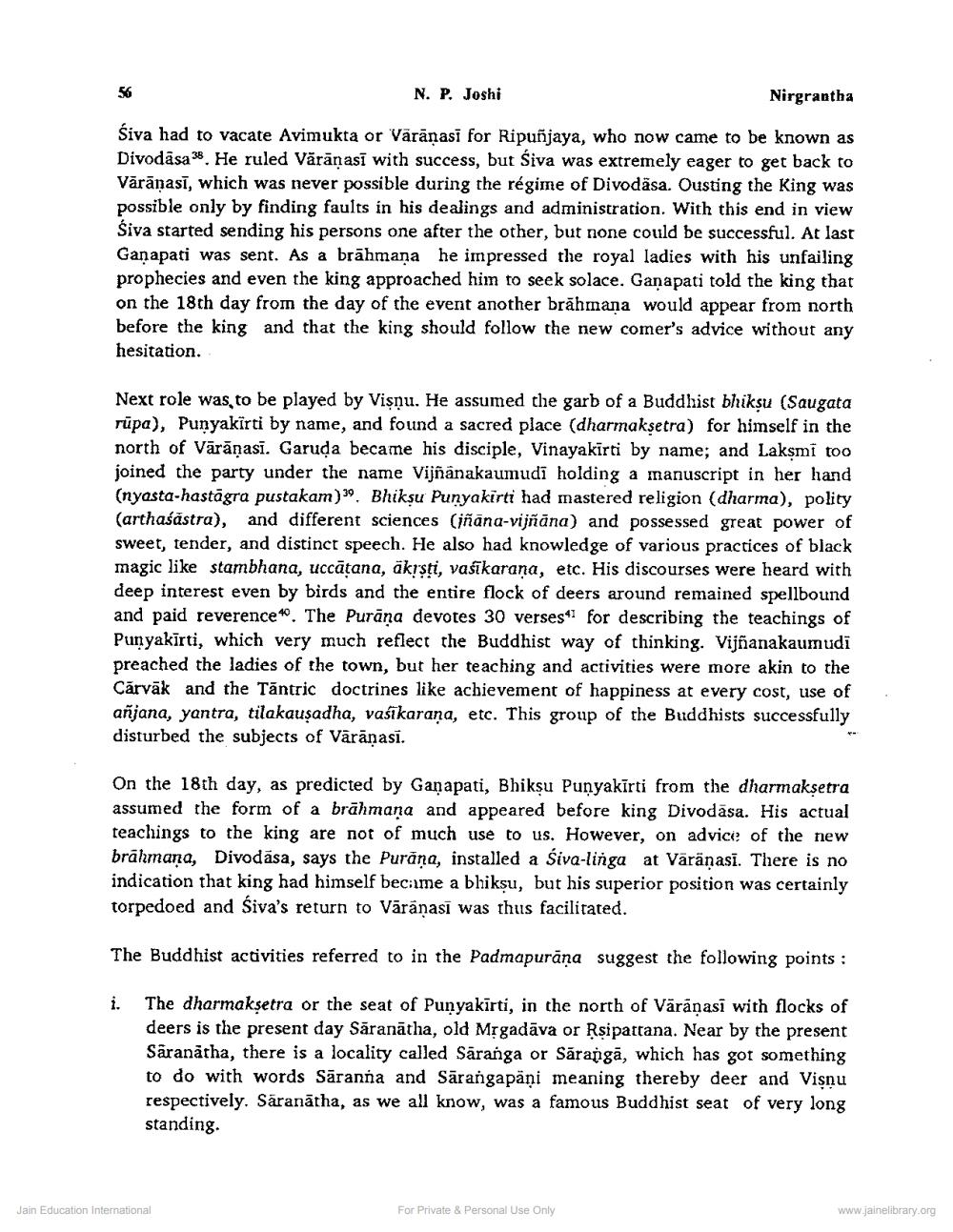Book Title: Teachers of Heterodox Sects Buddhism and Jainism in eyes of Puranas Author(s): N P Joshi Publisher: Z_Nirgrantha_1_022701.pdf and Nirgrantha_2_022702.pdf and Nirgrantha_3_022703.pdf View full book textPage 7
________________ N. P. Joshi Nirgrantha Siva had to vacate Avimukta or Värānasi for Ripuñjaya, who now came to be known as Divodása 38. He ruled Värānasi with success, but Śiva was extremely eager to get back to Vārāṇasī, which was never possible during the régime of Divodäsa. Ousting the King was possible only by finding faults in his dealings and administration. With this end in view Śiva started sending his persons one after the other, but none could be successful. At last Ganapati was sent. As a brāhmaṇa he impressed the royal ladies with his unfailing prophecies and even the king approached him to seek solace. Ganapati told the king that on the 18th day from the day of the event another brāhmana would appear from north before the king and that the king should follow the new comer's advice without any hesitation. Next role was, to be played by Vişnu. He assumed the garb of a Buddhist bhikṣu (Saugata rūpa), Punyakirti by name, and found a sacred place (dharmaksetra) for himself in the north of Vārāṇasī. Garuda became his disciple, Vinayakirti by name; and Lakşmi too joined the party under the name Vijnanakaumudi holding a manuscript in her hand (nyasta-hastagra pustakam) Bhiksu Punyakirti had mastered religion (dharma), polity (arthaśästra), and different sciences (jñana-vijñāna) and possessed great power of sweet, tender, and distinct speech. He also had knowledge of various practices of black magic like stambhana, uccātana, äkrsti, vašīkarana, etc. His discourses were heard with deep interest even by birds and the entire flock of deers around remained spellbound and paid reverence. The Purāņa devotes 30 verses" for describing the teachings of Punyakīrti, which very much reflect the Buddhist way of thinking. Vijfanakaumudi preached the ladies of the town, but her teaching and activities were more akin to the Cārvāk and the Tāntric doctrines like achievement of happiness at every cost, use of añjana, yantra, tilakauşadha, vašīkarana, etc. This group of the Buddhists successfully disturbed the subjects of Vārānasi. On the 18th day, as predicted by Ganapati, Bhikṣu Punyakīrti from the dharmaksetra assumed the form of a brāhmana and appeared before king Divodäsa. His actual teachings to the king are not of much use to us. However, on advice of the new brahmana, Divodása, says the Puriņa, installed a śiva-linga at Väräņasi. There is no indication that king had himself bec:ume a bhikṣu, but his superior position was certainly torpedoed and Siva's return to Varanasi was thus facilitated. The Buddhist activities referred to in the Padmapurana suggest the following points : i. The dharmakşetra or the seat of Punyakirti, in the north of Vārāṇasī with flocks of deers is the present day Sāranātha, old Mrgadāva or Rsipattana. Near by the present Säranátha, there is a locality called Sāranga or Sárangā, which has got something to do with words Sāranna and Sārangapäni meaning thereby deer and Vişnu respectively. Säranātha, as we all know, was a famous Buddhist seat of very long standing. Jain Education International For Private & Personal Use Only www.jainelibrary.orgPage Navigation
1 ... 5 6 7 8 9 10 11 12 13 14 15 16 17 18 19
